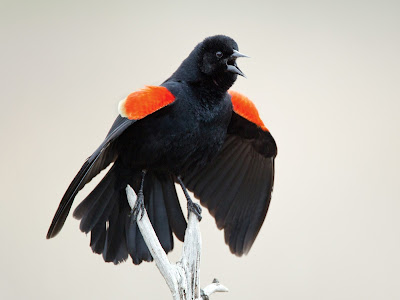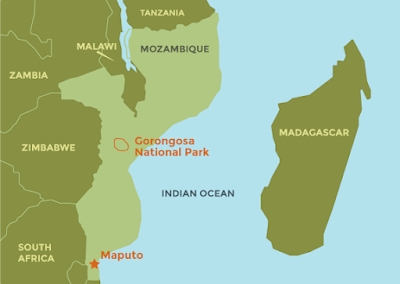A Northwoods Almanac for March 18 – 31, 2022
Spring Equinox and the Return of Red-winged Blackbirds
Over our 38 years of living in Manitowish, male red-winged blackbirds have returned nearly every year right around spring equinox. We live on the edge of a large wetland along the Manitowish River that is prime breeding habitat for red-wings, so the real estate mantra of “location, location, location” reverberates in red-wings every bit as much as it does in humans. They arrive commonly at this time even though snow and cold weather still prevail.
Red-winged blackbirds are among the earliest migrating songbirds to return in spring, sharing that title with grackles, robins, and starlings. I’d like to say they are harbingers of spring, but it’s like a commercial touting a movie that’s coming out a month or two later. Spring, or what we loosely refer to as spring in the North Country, is still a long ways off.
Red-winged males arrive around three weeks before the females. Part of that is due to the fact females typically migrate longer distances in autumn than males. The female populations located near the Great Lakes migrate nearly 140 miles farther south, so they have a longer flight back. Plus, females require a higher protein diet to lay eggs, so there’s little point returning to their breeding grounds before insects begin to hatch.
But the males’ risky early return is mostly about establishing themselves as the “owners” of the best territories. Red-wings are known for their polygynous social system – a dozen or more females are not uncommonly observed nesting on the territory of a single male. One study in Washington state showed 33 females nesting in a single male’s territory! This large harem, if you will, makes them one of the most highly polygynous of all bird species.
Territory owners, however, don’t necessarily sire all of the nestlings on their territories. Females, as well as the males, will copulate with more than one partner during a breeding season. “It’s not at all unusual for one brood to be sired by two or more males,” says Ken Yasukawa, professor emeritus of biology of Beloit College. “On my study area in Wisconsin, about one third of young were sired by males other than the territory owner.”
The fancy term for this is “polygynandrous,” meaning both males and females have multiple mating partners during a breeding season.
Others may simply call it promiscuous, fickle, unfaithful, or, dare I suggest, immoral!
But the red-wings don’t care what the righteous among us call them. Attracting the most females means a better chance of passing on their red-winged genes to the next generation.
The males will fiercely defend their territories during the breeding season. In fact, over a quarter of the male’s time is spent vigorously defending his territory from other males and predators, not hesitating to attack much larger animals, including people.
The attacks don’t always require a physical confrontation. Lots of fights are resolved quickly via the flashing of their red shoulder patches. The patches are used like epaulets on a soldier’s uniform to distinguish rank – the more bars and stars, the higher the rank.
In the world of red-wings, rank is conferred via the size and brightness of the red patch – the bigger and brighter, the higher the rank. The patches serve both to defend territories and attract females. If you see two males side-by-side showing their epaulets, they’re likely on the boundaries of their territories. If you see two males next to each other with one showing his red patch and the other concealing his, the territorial male is the one revealing the patch, and the other is the trespasser.
We see this all the time at our feeders – one male flashing his vivid red patch under the feeder, and the other males covering their patches so only a yellow line appears, conveying a clear message of submission – we bow to thee.
The males also sing a blue streak in the early spring mornings, singing at a rate of 10 songs a minute, all to demonstrate another measure of vigor, status and strength. He with the loudest voice typically prevails.
The red-wings distinct “konk-la-reee,” often with an ending trill, will soon be ringing across the wetlands, and for Mary and me, it’s greatly welcome, suggesting at last that spring may be on some distant horizon.
Owl Activity
We have three quite common nesting species of owls in the Northwoods: northern saw-whet, barred, and great horned. We also have four other owl species that are at the other end of the nesting spectrum, highly uncommon to rare: short-eared, eastern screech, great gray, and long-eared. And we have three species that are rare winter visitors: snowy, northern hawk, and boreal.
As I wrote in an earlier column, great horned owls should be incubating eggs now, with a hatch date likely in early to mid-April.
Barred owls follow a later breeding calendar, laying their eggs sometime between late March and mid-April, with an incubating time of about a month. So, their hatch date is late-April to mid-May. They call during all months of the year, but most frequently from February to mid-March, so hopefully some of you have been hearing them recently.
You may also soon be hearing the night-time advertising call of northern saw-whets, a call that is a monotonous series of whistled notes on a constant pitch, often likened to the beeping sounds made by a dumptrack backing up, except the saw-whet call continues every second for ten or more minutes before pausing.
Some folks are reporting local owl action. Debbie and Randy Augustinak in Land O’Lakes sent me a note and a photo on 2/26 regarding a northern saw-whet owl that was mousing under their feeders at daybreak. They noted, “He was quite approachable,” a common behavior of saw-whets who for some reason don’t seem to fear humans. When I cautioned that seeing an owl in late winter at your bird feeders is often a sign of starvation, they replied, “The good news is we do see lots of mice and voles there, usually when we click on the yard light at night, so maybe he got lucky. He hung around all day in the bright sunshine until we left for church around 3 p.m. He was gone when we got home at 5 p.m.”
Sterling Strathe in the Eagle River area shared a beautiful photo he took of a barred owl near his feeders on 3/5. He commented, “Watched this ‘guy??’ miss a red squirrel this afternoon.” His question mark regarding the gender makes sense, because there’s no way to visually tell the genders apart, a truism for most owl species.
As for snowy owls, 143 were reported in January in 54 of Wisconsin’s 72 counties, but none that I’m aware of are currently in Vilas, Oneida, or Iron counties.
Black Bears
We’re getting closer to the time when black bears will be leaving their dens. According to Lynn Rogers, a well-known bear researcher in Minnesota, males are typically the first to leave their dens, often in late March around here. However, when they leave depends on snow depth, and our current snow is still quite substantial.
The females emerge later in April. Currently, many are actively nursing cubs which weighed less than one pound when born, but which will weigh more than 5.5 pounds when they leave the den with the mother.
Black bears breed in June or early July, but by utilizing delayed implantation, embryonic growth does not begin until five months after breeding. The period of active pregnancy then lasts only about six weeks, and the cubs are born in late January or early February.
How to Tell a Coyote from a Wolf
Bev Engstrom shared a great photo of a coyote near her home on the Wisconsin River, which always brings up the question of how to tell a coyote from a wolf. It’s difficult! Here are three keys to look for:
Size: Coyotes are much shorter, standing 20 to 22 inches; wolves stand 27 to 33 inches.
Coyotes are 3.5 to 4.5 feet in length; wolves are 5 to 6 feet in length.
Coyotes weigh 25 to 40 pounds; wolves weigh 60 to 120 pounds.
Coyote tracks average 2.5 inches in length; wolf tracks are 4 to 5 inches long.
Ears: Coyotes have proportionally longer ears with pointed tips. Wolves have shorter and more rounded ears.
Snout: A wolf has a broad, more rounded snout, while a coyote has a narrow and pointier snout.
Unless you have a coyote and a wolf standing near each other, however, these can be relatively subtle differences. I find it often quite difficult to distinguish between a coyote and a wolf, particularly if it’s a brief sighting, the animal is far away, or if the lighting is poor.
Look at Bev’s photo and see in particular the small size, narrow face and pointy ears.
Celestial Events
The full moon occurs tomorrow night, March 18. Two names are most often attributed to it: the “Sap or Maple Sugar Moon” and the “Crust on Snow Moon.”
The official vernal equinox takes place on March 20 when the sun travels directly above the equator. We’re now the recipients of longer days than nights – hallelujah! “Spring” lasts 92 days according to the calendar, but don’t believe it for a second.
Look to the southeastern horizon before dawn in late March through early April to spot a tri-planetary tango of Venus, Mars, and Saturn all clustered close together. On 3/29, look for Venus just two degrees above Saturn. On 3/30, look for Jupiter four degrees above the waning crescent moon.
Ice Storm and Crust Snow
The ice storm that hit our area on 3/5 left a hard crust on top of some pretty deep snow. For deer, this is really an exhausting time of the year as they posthole through the crust. On the other hand, light animals with big feet – aka a snowshoe hare – they’ve found nirvana.
Thought for the Week
All knowledge is local, all knowledge is partial. – Ursula K. Le Guin
And along those same lines: No matter how intently one studies the hundred little dramas of the woods and meadows, one can never learn all the salient facts about any one of them. – Aldo Leopold







